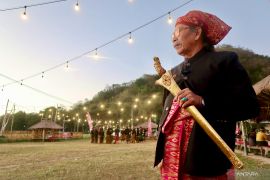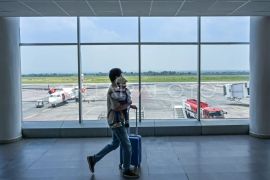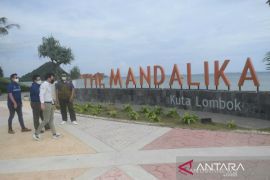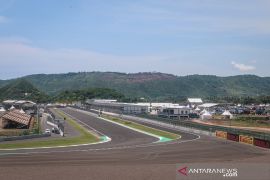Serving as a token of local knowledge that has proven its utility over the course of time, the Bayan traditional building sits in Bayan village, North Lombok, West Nusa Tenggara.
A resident of Pujut sub-district, Lombok district, West Nusa Tenggara, points it out as an example of the adoption of local wisdom for natural disaster mitigation during an interview with ANTARA on May 18, 2022.
According to Lalu Sunting Mentas, local wisdom, which is reflected or incorporated in the construction of the balai balak buildings, must be preserved as part of the effort to anticipate the risk of earthquakes.
"Indonesia's location, situated on three grand plates, which are Pacific and Indo-Australia, has resulted in high risk of disaster, including in West Nusa Tenggara area; thus, local knowledge is needed in constructing buildings," Mentas said.
He saw the importance of local wisdom in efforts to anticipate disaster risks in the future. Back in olden times, the Sasak tribe constructed buildings that could withstand tremors in the Earth. They were designed of wood and had a pointed shape, akin to balai balak buildings.
People in the past believed that their houses were earthquake-proof. However, current construction materials are not as durable as they used to be, thus making them prone to fire, he said.
The construction of people's homes has drastically changed with technological development, Mentas highlighted. He said he expects the government to incorporate building construction that does not disregard the old, traditional local wisdom, which enabled people in the past to live in earthquake-proof houses.
"Nowadays, there are many permanent buildings constructed by people, but they are not earthquake-proof. Even though there are large buildings that are getting constructed, there must be some local knowledge (incorporated in the process)," he added.
Apart from that, the ritual is also important, he said. In the tradition called selamat laut, heads of black and red buffaloes were presented as sacrifices to repel bad omens.
Although modern people deem such things as myths, people in the past extensively offered such sacrifices, and residents of Pujut sub-district still perform the sacrifice prior to constructing houses or large buildings, he informed.
According to older beliefs, the buffalo heads helped negate impending doom, he said.
In fact, local wisdom had saved people back in 1978 and helped them face sudden natural disasters. There were no loudspeakers back then. However, the kentongan (a traditional bamboo slit drum) proved vital for ensuring people’s security and in efforts to mitigate natural disasters.
"The (sound of) kentongan being hit served as a sign to gather the people, or as a warning of coming disaster," he said.
Such local wisdom must be embraced, and it is expected that future generations would acknowledge it and become aware of the culture of West Nusa Tenggara, and Central Lombok, in particular.
"Our future generations must be informed of local wisdom," he said.
Using kentongan for disaster warning
According to the Mataram Disaster Mitigation Agency, West Nusa Tenggara, kentongan and beduk (drum) are among the items of local wisdom that are still largely used and have proven effective as methods of early disaster warning for the public.
"The two articles of local knowledge are still used as (part of) disaster mitigation. The others have changed, following the development of time and technology," secretary of the agency, Akhmad Muzaki, said.
Usually, the two are sounded when a disaster strikes.
Muzaki said that the kentongan and beduk function as an early warning system, an important part of the whole public preparation mechanism, and bridge two stages: alertness and emergency.
"Kentongan and beduk are (a form of communication) in a language which is understood by the public," he said.
Their use is designed to instill public awareness and garner an immediate response, because the speed with which people respond is crucial in facing disasters.
Other early warning systems that have been implemented with current technological advancements are sirens and loudspeakers.
"As for tsunami detectors, we have tsunami EWS on the shores of Penghulu Agung Beach. On the 26th of every month, we activate (the device) to make sure that it is still properly functioning," he said.
Mataram is one of the 10 districts and cities in West Nusa Tenggara that are often hit by six types of 10 disasters. Apart from earthquakes accompanied by tsunamis, other threats that loom large on Mataram city include floods, fires in residential places or neighborhoods, waves upon shores, abrasion, and social conflicts.
The West Nusa Tenggara provincial government is committed to improving regional development planning in terms of mitigation of disaster risk.
"We are ready to face earthquakes, tornadoes, floods, droughts, landslides, volcanic eruptions, and tsunamis," regional secretary of West Nusa Tenggara, H.L. Gita Ariadi, said.
The West Nusa Tenggara provincial government has created documents on disaster mitigation, he added. They include studies on disaster risk and plans to mitigate it. The government has made "resilience in the face of disaster” its first and foremost goal.
"This means that we have the ability and resilience to face and survive disasters," he added.
It is hoped that the marriage of modern science and local wisdom bears fruit, so that people in the Lesser Sunda Islands can better anticipate disasters.
Related news: BRIN scheme to support documentation of local wisdom
Related news: Local wisdom critical for environmental sustainability: minister
Editor: Rahmad Nasution
Copyright © ANTARA 2022












